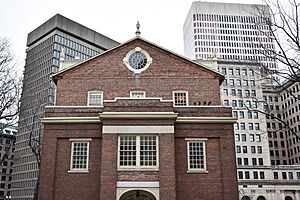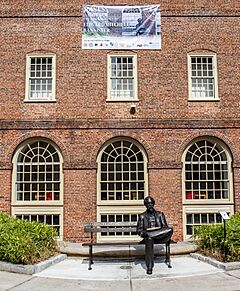Market Square, Providence, Rhode Island facts for kids
Market Square is a special public space in Providence, Rhode Island. It's found where North Main Street and College Street meet, right at the bottom of College Hill. For a long time, Market Square has been a very important place for shopping, community events, and culture in Providence.
Contents
History of Market Square
Early Days in Colonial Providence
In the 1600s, the land where Market Square now stands belonged to Chad Brown. His family later became famous for their connection to Brown University.
Market Square officially began in 1738. The town leaders of Providence decided to create a wide road, about 123 feet across. This road stretched from Towne Street (now South Main Street) to the Great Bridge. Back then, this area was known as the Town Parade.
By 1744, a Haymarket, a place to buy and sell hay, was set up here. This helped make the square a key spot for business in the area.

The most important building in the square, Market House, was built between 1773 and 1775.
On March 2, 1775, people in Providence gathered in Market Square. They were upset about the Tea Act, a tax on tea from England. This protest was inspired by the famous Boston Tea Party. The colonists piled up a lot of English tea in the middle of the square. They covered it with a barrel of tar and set it on fire!
Market Square and Black History
Market Square was a busy business center in colonial Providence. Because of this, some historians think it might have been a place where enslaved people were traded. However, old records don't clearly confirm this. Most sales of enslaved people in Providence usually happened in private businesses, not in a big public square.
Enslaved Black workers helped build the Market House in 1775. One of these workers was Pero Paget, a skilled stonemason. He also helped build University Hall at Brown University.
In the 1700s and 1800s, Market Square was also an important place for free Black business owners in Providence. They used the square to sell their goods and services.
Market Square in the 1800s
In June 1843, President John Tyler visited New England. He was thinking about running for president again. One of his stops in Providence was at Market Square. The president enjoyed a meal at the Franklin House, an inn located across from the Market House.
In 1847, the Union Station was built. This new train station caused the main business area of Providence to move to Exchange Place in Downtown Providence.
During the American Civil War, Market Square was a place for public "war meetings." The mayor, Jabez C. Knight, led these meetings. City leaders and important people made announcements and tried to get more people to join the Union army. They also tried to get support for the war.
One meeting in August 1862 announced the Militia Act of 1862. This law allowed the state to draft people into the military. It also allowed African-Americans to join the war as soldiers and workers. People cheered loudly when this was announced! Governor William Sprague IV asked "colored citizens" to form their own army group. He even promised to go with them into battle. In July 1863, after a national draft was started, an official picked names of drafted men from a wheel in Market Square.
In 1882, the first electric arc lights in Providence were installed. They lit up Market Square and Westminster Street.
On September 7, 1897, a famous speaker named Emma Goldman was arrested at Market Square. She was speaking outdoors and attracting a crowd. The mayor of Providence had warned her not to speak in the city. She was giving talks about different topics like "Why I am an Anarchist-Communist" and "Woman." After being held overnight, the Providence police told her to leave town within 24 hours or face three months in jail.
Market Square and RISD
The Rhode Island School of Design (RISD) bought Market House in 1948. Today, Market Square is surrounded by the school's buildings.
In 2016, students organized a protest called 'Not Your Token' in Market Square. They were protesting against racism and unfair treatment at the school. Student groups created a list of demands. These included hiring and keeping more teachers of color, training for teachers, and changes to the school's classes. The protestors also asked for a memorial in Market Square. This memorial would recognize the square's possible connection to slavery and honor those who suffered from slavery in Rhode Island.
In September 2023, a bronze statue of Providence artist Edward Mitchell Bannister was placed in Market Square. The statue, made by local artist Gage Prentiss, shows Bannister sitting on a bench.
Gallery









